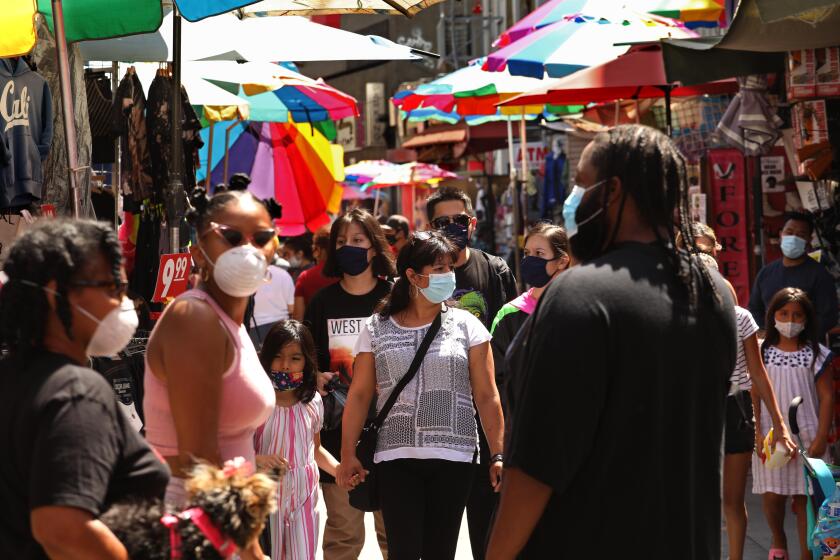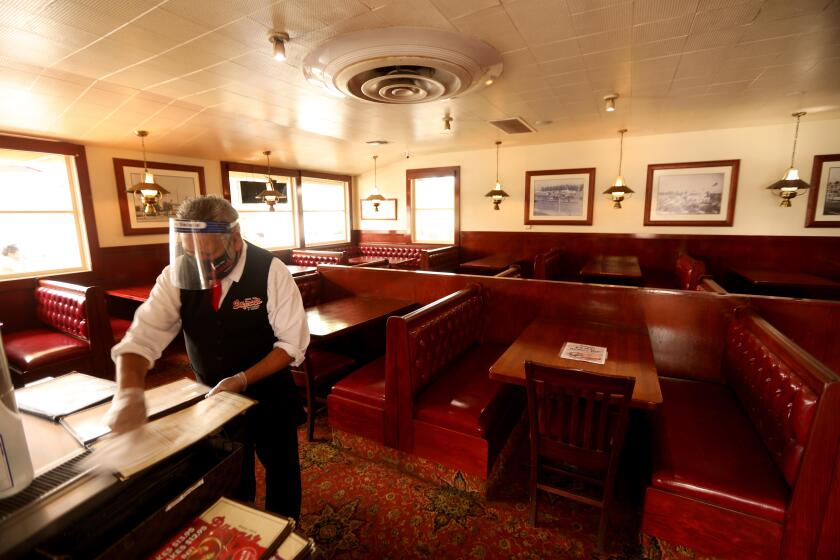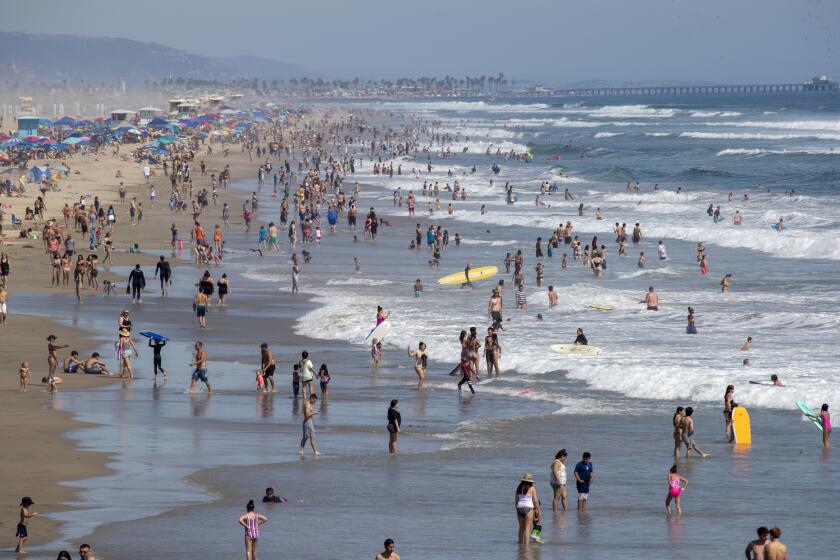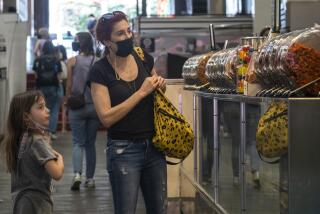As coronavirus surge continues, L.A. unveils color-coded system to assess infection risk
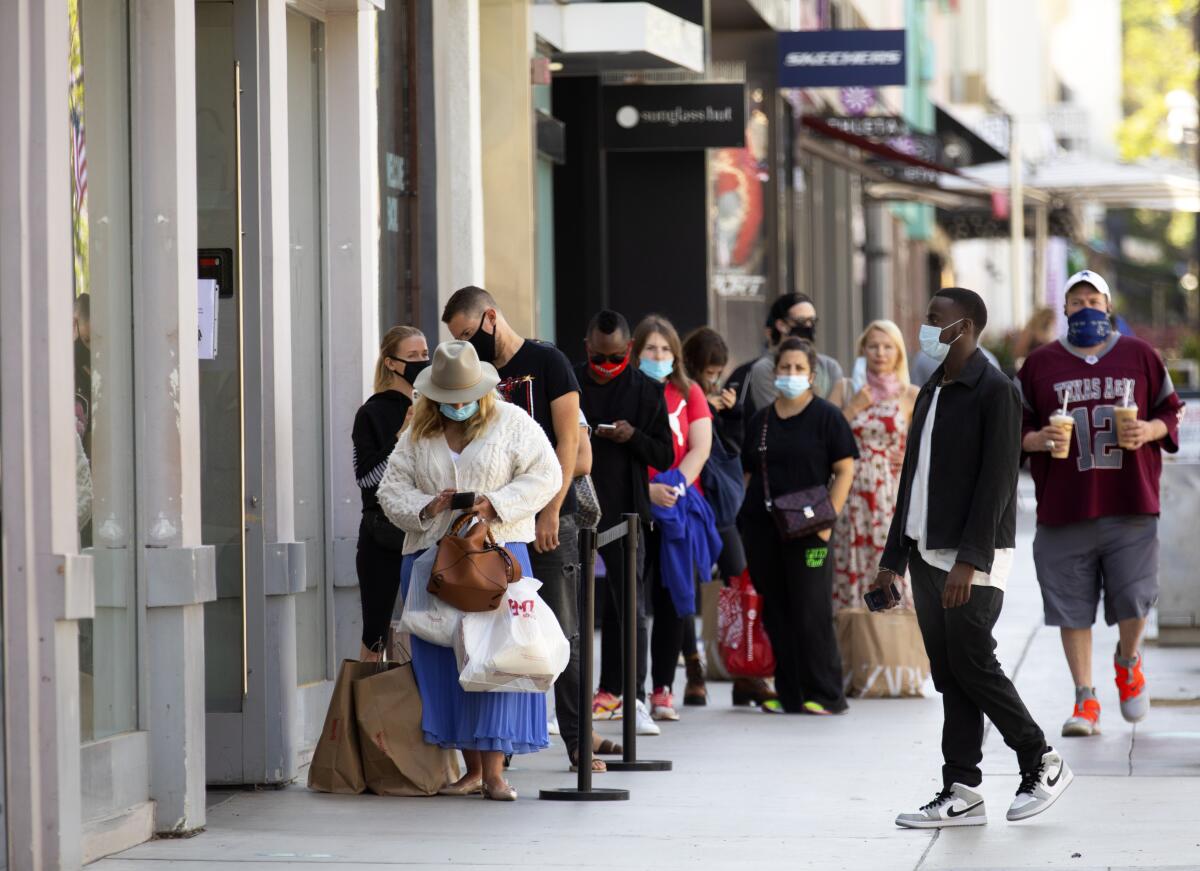
As coronavirus cases continue to mushroom throughout the state, Los Angeles has unveiled a new color-coded system to assess and report the risk of infection.
The online indicator, which Mayor Eric Garcetti unveiled Wednesday, is broken into four categories — red, orange, yellow and green — each representing different threat levels.
“Information and data on the threat helps us all inform our behavior, guides us to better days,” Garcetti said.
As of Thursday morning, L.A.’s indicator was orange, meaning that the risk of infection remains very high, according to Garcetti.
“When the indicator is orange, you want to stay at home as often as possible ... and only leave for essential activities like going to work or going to the market,” he said. “And you should assume everyone around you is infectious.”
Red, the highest threat level, would mean that “residents must stay at home and take precautions and will likely be on a mandated safer-at-home order,” Garcetti said.
The orange zone means that people without vulnerabilities should use their discretion.
Yellow means “we’re successfully flattening the curve” and green “will indicate that COVID-19 is mostly contained and presents a very low risk to Angelenos,” he added.
“We all want to live in that green and yellow area until there’s a cure or a treatment for COVID-19,” he said.
The new tool was released as Los Angeles, like many areas in the state and nation, continues to see distressing spikes in coronavirus infections and hospitalizations.
On Thursday, there were 1,893 patients with confirmed infections in L.A. County hospitals — up from 1,429 two weeks earlier.
“Whether we stop the threat of COVID-19, whether we save lives and preserve livelihoods, is up to us,” Garcetti said. “COVID-19 has taken control, and it’s time for us to take control back.”
Statewide, the number of people hospitalized with coronavirus has shot up 56% in the last two weeks — from 3,337 to 5,196. Coronavirus cases also have surged, setting four daily records over that same time frame.
As of Thursday afternoon, the total number of confirmed infections statewide had surpassed 241,000. Almost 6,200 Californians have died from COVID-19.
After four daily infection records in the last two weeks, officials fear social gatherings could bring even more outbreaks over the July 4 weekend.
So severe are the recent increases that some counties, including San Bernardino and Riverside, have said they are prepared to open overflow facilities as their hospitals approach surge capacity.
The state also announced the reactivation of four alternate care locations Wednesday — the Imperial Field Medical Site, Seton Medical Center, Fairview Developmental Center and Porterville Developmental Center. Combined, those facilities will make hundreds of additional beds available to relieve stress on the healthcare system.
“As hospitalizations continue to rise, these alternative care sites will expand capacity and support additional acute care specifically dedicated to COVID-19 patients,” according to the California Governor’s Office of Emergency Services.
Amid the worsening outbreak, Gov. Gavin Newsom on Wednesday ordered 19 particularly hard-hit counties to walk back some reopenings and halt visits to indoor restaurants, bars, wineries and tasting rooms, entertainment centers, movie theaters, zoos, museums and card rooms for the next three weeks.
Gov. Gavin Newsom restricts indoor dining, tasting rooms, entertainment centers, movie theaters, zoos, museums and card rooms in California counties struggling to control the coronavirus.
Counties affected by the order include Los Angeles, Riverside, Ventura, Orange, San Bernardino and Sacramento.
The Newsom administration’s decision to impose tougher rules in those counties comes just weeks after the state allowed restrictions to be eased in most of the state.
Businesses in the affected counties are still allowed to remain open for outdoor service and takeout. Bars and other drinking establishments are also allowed to seat guests outdoors as long as they sell a meal with drinks in the same transaction and meet all of the same safety requirements as restaurants.
On Thursday, Garcetti said outdoor restaurant dining is not discouraged by the city but also acknowledged that he will be getting take-out.
“That’s not the place where you probably are going to get infections,” Garcetti said, adding that infections come when people are in a closed environment and near one another.
“We’re in the second or third inning of this nine-inning game,” Newsom said Thursday. “By no stretch are we out of the woods, but we can influence, we can mitigate the spread, we can again bend this curve.”
A major thrust of that effort is wearing masks while in public or high-risk settings — which Newsom mandated statewide on June 18.
Newsom on Thursday announced the launch of a public-awareness campaign aimed at driving home the importance of wearing face coverings, which public health officials say can help prevent those who are infected with the coronavirus from spreading it to others.
The campaign is being funded in part by donations from the Chan Zuckerberg Initiative, the foundation of Facebook founder Mark Zuckerberg and his wife, pediatrician Priscilla Chan. Los Angeles developer Rick Caruso and former Democratic presidential candidate Tom Steyer also donated to the campaign.
However, the issue of enforcement has remained an open question, with some local governments or law enforcement agencies saying they won’t punish residents for not adhering to the mask mandate.
Newsom acknowledged there are limitations to how far the state can go in terms of enforcement — “There are laws on the books that, if we tried to enforce at scale, we never could that transcend and predate COVID-19” — and said that’s why public education and encouragement are so important.
“If 40 million people want to turn their back on civil society and abuse the rules, laws and regulations on a consistent basis at scale, then society begins to erode,” he said. “Accordingly, the health of a community begins to be diminished. We have a health crisis in this nation. We are not out of this crisis; we’re still in the first wave of this crisis. It requires some level of personal responsibility.”
As infections continue to climb, officials are pleading with residents to not gather with friends or family members they don’t live with over the Fourth of July weekend.
Newsom said state public health officials are gravely concerned that Californians will let their guard down during one of the most social holidays of the year, traditionally a festive time celebrated with backyard barbecues, crowded public fireworks shows and trips to beaches, rivers and lakes. Those gatherings have the potential to accelerate the spread of the coronavirus.
To that end, officials have moved to stave off some of the communal traditions that typically mark the holiday. The vast majority of Southern California’s beaches will be closed for the Fourth of July weekend, and Newsom has recommended that all fireworks shows be canceled in the most impacted counties.
Los Angeles and Ventura counties will close beaches for the entire holiday weekend, while several Orange County cities will close their shores Saturday.
“This is not going to be the type of Fourth of July weekend that most of us are used to — nor should it be,” L.A. County Supervisor Janice Hahn said in a statement.
“The spike we have seen in COVID-19 cases and hospitalizations across our county should alarm all of us. We all have to make personal sacrifices to protect the people we love and our communities from this virus.”
San Francisco city and community leaders also held an online news conference Thursday to urge residents to stay home for the holiday.
Dr. Grant Colfax, the city’s public health director, said San Francisco has experienced a “significant and alarming increase in COVID-19 infections.”
“Our rates have soared,” he said. “We are in a situation where we could be seeing early signs of surge.”
Local hospital capacity remains in good shape, however, and the city is accepting patients from other harder-hit areas — including 18 inmates from San Quentin State Prison, he said.
“Once this virus takes off at a high rate, it is very aggressive,” Colfax said.
Times staff writers Rong-Gong Lin II, Colleen Shalby, Alejandra Reyes-Velarde, Hannah Fry, Taryn Luna, Dakota Smith and Stephanie Lai contributed to this report.
More to Read
Sign up for Essential California
The most important California stories and recommendations in your inbox every morning.
You may occasionally receive promotional content from the Los Angeles Times.
